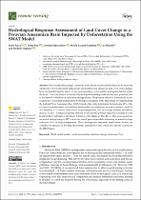Hydrological Response Assessment of Land Cover Change in a Peruvian Amazonian Basin Impacted by Deforestation Using the SWAT Model
Resumen
The watershed hydrologic conditions in the Madre de Dios (MDD) Basin in the Peruvian Amazon have been irreversibly impacted by deforestation and changes in land cover. These changes have also had detrimental effects on the geomorphology, water quality, and aquatic habitat within the basin. However, there is a scarcity of hydrological modeling studies in this area, primarily due to the limited availability of hydrometeorological data. The primary objective of this study was to examine how deforestation impacts the hydrological conditions in the MDD Basin. By implementing the Soil and Water Assessment Tool (SWAT) model, this study determined that replacing 12% of the evergreen broadleaf forest area with bare land resulted in a significant increase in surface runoff, by 38% monthly, a 1% annual reduction of evapotranspiration, and an average monthly streamflow increase of 12%. Changes in spatial patterns reveal that the primary impacted watershed is the Inambari River subbasin, a significant tributary of the Madre de Dios River. This area experiences an annual average surge of 187% in surface runoff generation while witnessing an annual average reduction of 8% in evapotranspiration. These findings have important implications, as they can contribute to instances of flooding and extreme inundation events, which have already occurred in the MDD region.







